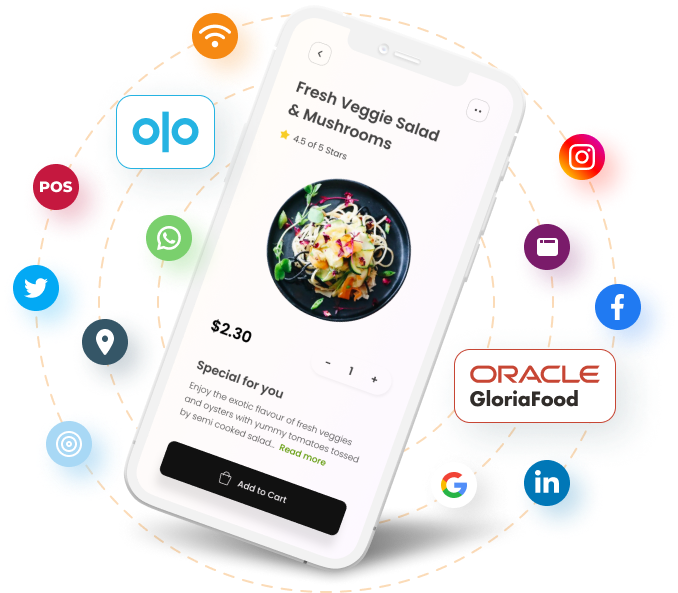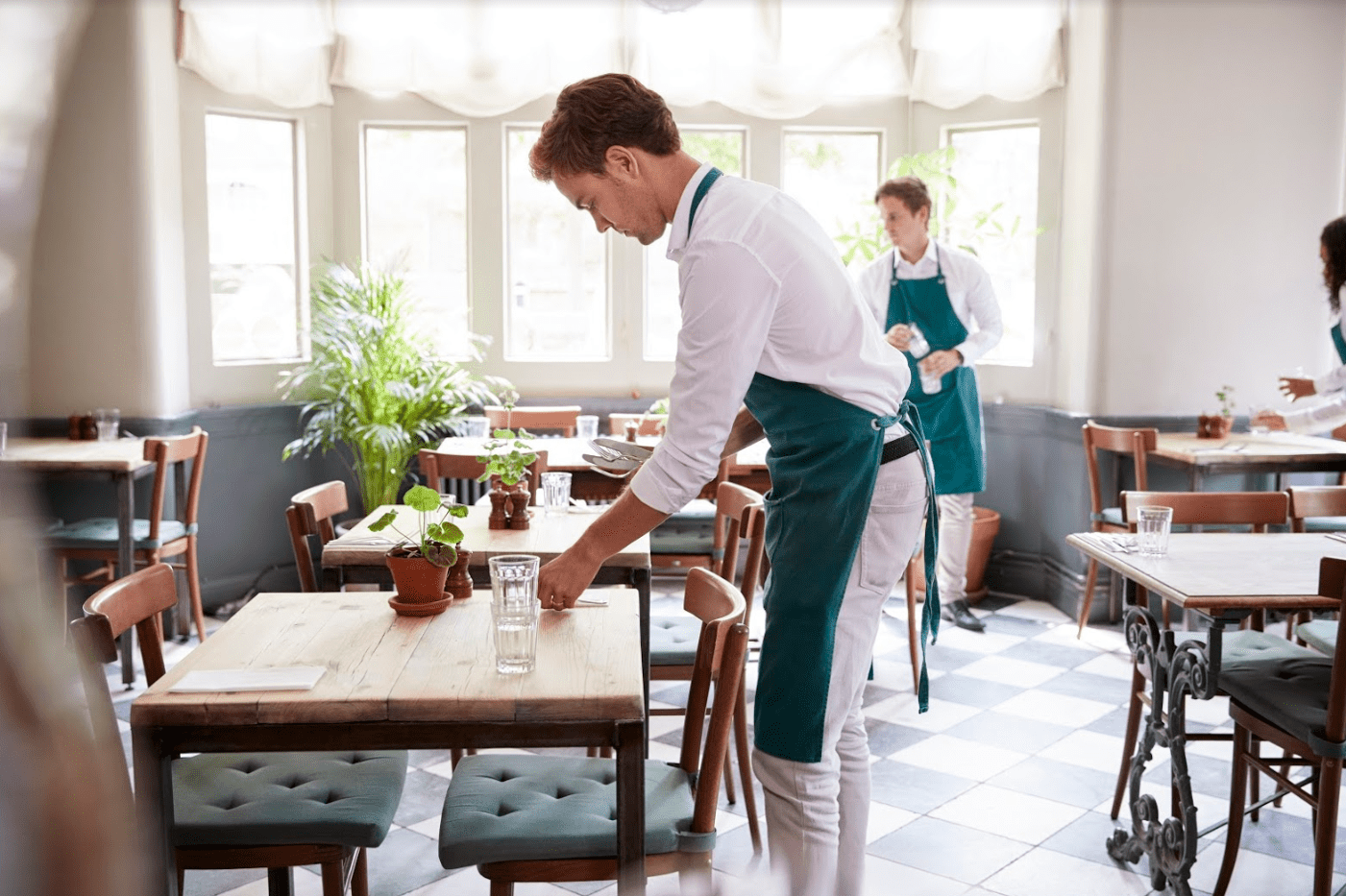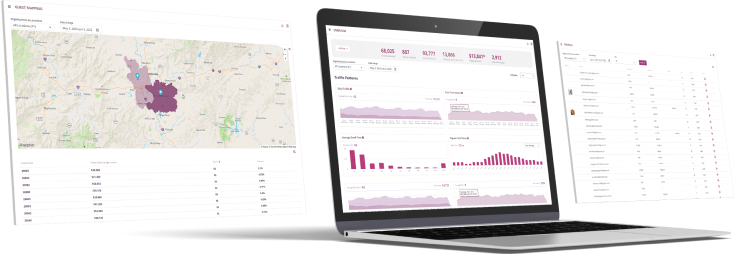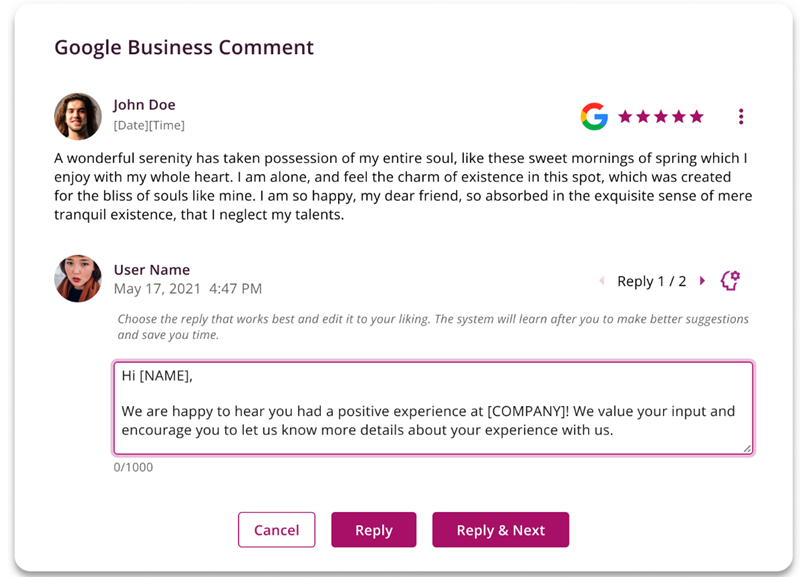Fine Dining Marketing: 9 Tips To Grow Your Business
Learn What Fine Dining Marketing is and How to Create Demand for Your Restaurant

Scroll to explore
Fine dining marketing offers a unique challenge. While the food, service, and ambiance are essential parts of the package, they’re not the only things that matter.
You need to let potential guests know what you offer and why they should choose your restaurant over others. This is where effective fine dining marketing comes in.
This article is for marketers, managers, and owners in the fine dining industry who are looking for clear, straightforward strategies to attract more guests and keep them coming back.
There’s a lot to consider when marketing a fine dining restaurant, and it can be easy to get lost in the details. But with a solid understanding of the basics and a willingness to adapt to changing trends, you can position your restaurant for success.
This article aims to provide you with the knowledge and tools you need to do just that. Whether you’re new to the industry or looking to enhance your current restaurant marketing strategies, there’s something here for you.
Keep in mind that the best marketing strategy is one that aligns with your restaurant’s unique offerings and values. Remember that the goal is to attract guests who will appreciate and enjoy what you have to offer.

Why Is Fine Dining Marketing Important for Success?
Fine dining is not just about the food, it’s about the experience. It’s the immersive atmosphere, exceptional service, meticulously curated dishes, and an ambiance that complements these elements.
Fine dining establishments are known for their culinary expertise and artistic presentation. However, the critical piece that ties all these elements together and brings guests through the door is effective marketing.
The importance of fine dining marketing cannot be overstated, and here are several reasons why:
- Brand Awareness: In an increasingly competitive industry, marketing helps fine dining restaurants stand out. It builds brand awareness, highlighting unique selling points, from innovative culinary techniques to sourcing local and organic ingredients. Without effective marketing, even the most outstanding establishments may go unnoticed.
- Guest Acquisition and Retention: Marketing helps to attract new patrons and retain existing ones. Special promotions, events, loyalty programs, and personalized communication strategies are all tools that can attract and retain a restaurant’s clientele. This continuous guest engagement not only improves revenue but also fosters a loyal customer base that can become brand ambassadors.
- Online Presence: In the digital age, a strong online presence is essential. Many guests check online reviews, ratings, and websites before choosing a restaurant. A well-designed website, positive online reviews, and an engaging social media presence can dramatically improve a restaurant’s visibility and reputation.
- Communication: Marketing provides a platform for communication. It allows restaurants to share their story, values, and unique offerings. It also provides a channel for receiving guest feedback, which is invaluable for understanding guest preferences and improving service.
- Economic Sustainability: Given the high operating costs and competitive nature of the fine dining industry, effective marketing strategies are vital for economic sustainability. By optimizing pricing strategies, promoting special events, and showcasing premium offerings, marketing helps to drive revenue and maintain a healthy bottom line.
Fine dining marketing is a crucial aspect of a restaurant’s operations. It helps shape a restaurant’s image, attracts and retains guests, and is instrumental in driving revenue.
With a carefully crafted and well-executed marketing strategy, fine dining establishments can flourish in a competitive market.

1. Invest in a Customer Data Platform
In fine dining, a restaurant customer data platform (CDPs) like Bloom Intelligence serves as the recipe for marketing success. By consolidating and organizing guest data from various sources into a unified platform, CDPs enable fine dining restaurants to offer a personalized and seamless dining experience to their patrons.
Here are other reasons why investing in a customer data platform is essential for successful fine dining marketing.
- Guest Personalization: CDPs help restaurants collect and analyze guest data like dining preferences, past order history, online and offline behavior, special occasions, and more. This knowledge enables restaurants to tailor experiences that exceed expectations, delighting the guest and fostering loyalty. A personalized touch in the fine dining industry can make the difference between a one-time visitor and a lifelong patron.
- Effective Communication: With a unified, 360-degree view of the guest, restaurants can create targeted marketing campaigns that resonate with their clientele. Whether it’s a personalized email offering a complimentary dessert for a patron’s birthday, or an email alert about a new seasonal menu based on past dining preferences, effective communication nurtures the guest relationship.
- Optimized Marketing Efforts: CDPs allow fine dining establishments to track their marketing efforts accurately, providing insights into which strategies are working and which are not. It enables marketers to adjust their efforts accordingly, leading to improved efficiency and a higher return on investment.
- Improved Guest Retention: By understanding guests’ dining habits and preferences, restaurants can predict future behavior and proactively engage with patrons. For example, if a regular guest has not booked a table in a while, a personalized message could reignite their interest and bring them back.
- Enhanced Customer Service: Access to guest data can empower staff to provide exceptional service. Knowing a guest’s preferences or dietary restrictions in advance helps the team cater to these needs efficiently, enhancing the overall dining experience.
- Data-Driven Decision Making: Lastly, CDPs can support data-driven decision making. From menu changes to operational adjustments, having concrete data allows restaurants to make informed decisions that can drive profitability and guest satisfaction.
In an era where “the customer is king” and personalized experiences are highly valued, a CDP can be a game-changer in the world of fine dining marketing.
By offering rich, data-driven insights, it empowers restaurants to create unforgettable dining experiences that can turn guests into brand advocates.

2. Collect Guest Data From Multiple Sources
Building a deep understanding of your guests is crucial in the fine dining industry.
One of the most effective ways to do this is by collecting guest data from multiple sources such as Wi-Fi logins, online ordering and reservations, Point of Sale (POS) systems, website forms, and social media accounts.
A restaurant CDP like Bloom can easily do this for you, allowing you to passively build a large and clean guest database.
The use of multi-source data collection offers several significant advantages:
- Comprehensive Guest Understanding: Different data sources offer different perspectives on your guests. Wi-Fi logins can tell you about their visit frequency, online orders can reveal their favorite dishes, reservations can shed light on preferred dining times, POS systems can track spending habits, website forms can provide contact details and preferences, and social media accounts can share broader interests and interactions. Collecting data from these multiple sources enables you to form a more holistic understanding of your guests.
- Personalized Marketing and Engagement: With a complete guest profile, your marketing efforts can be more targeted and personalized. This could involve sending tailored offers based on a guest’s behavior, or planning unique dining experiences based on their preferences. Personalized engagement enhances guest loyalty and increases the chances of return visits.
- Enhanced Guest Experience: A thorough understanding of your guests also enables you to provide superior service. For example, if a guest has previously indicated dietary restrictions through an online order, the kitchen can be prepared in advance for their next visit, thereby ensuring a smooth and enjoyable dining experience.
- Informed Business Decisions: Collecting guest data from various sources can provide valuable insights that inform your business decisions. For instance, if data from online reservations shows a preference for dinner reservations over lunch, it might be beneficial to allocate more resources to the dinner service.
- Guest Retention: By using data to understand and meet your guests’ needs, you improve their overall experience and increase the likelihood of them returning. The more data you collect from different sources, the better equipped you are to offer an experience that truly resonates with your guests.
Collecting guest data from multiple sources is not just beneficial, but necessary in the modern fine dining industry.
It enables you to fully understand your guests, deliver personalized experiences, make data-driven decisions, and ultimately, ensure the sustained success of your restaurant.

3. Implement WiFi Marketing Strategies
Beyond exquisite culinary offerings and unparalleled service, leveraging technology, like WiFi marketing, is becoming increasingly critical in shaping these experiences and establishing long-term relationships with guests. Let’s dive into the importance and application of WiFi marketing in the fine dining industry.
- Guest Data Collection: Offering complimentary WiFi is not just a service to guests but also a valuable data collection tool. As guests connect to the restaurant’s WiFi, they typically provide contact information or connect through social media accounts, providing the restaurant with their basic information and potentially their preferences.
- Personalized Marketing: With WiFi marketing, fine dining establishments can track the frequency of guests’ visits and their time spent at the restaurant. These insights can be used to send personalized messages. For example, if a guest frequently dines at your restaurant, sending them a personalized ‘thank you’ email with a special offer can go a long way in fostering loyalty.
- Real-Time Engagement: WiFi marketing also enables real-time engagement. You can send a welcome message as soon as a guest logs into your WiFi, offering them the special of the day or informing them about any events or promotions. Such real-time communication not only makes guests feel valued but also enhances their dining experience.
- Social Media Promotion: By integrating your WiFi login with social media, you can encourage guests to check in, post, or share about their experience at your restaurant. This user-generated content serves as an endorsement of your restaurant and can significantly boost your online visibility.
- Customer Retention: WiFi marketing allows fine dining establishments to re-engage with past guests. By sending periodic emails about new menu items and upcoming events, or simply saying “we miss you,” you can encourage previous guests to revisit.
In summary, WiFi marketing is a powerful tool in the arsenal of fine dining marketing strategies.
By using it effectively, restaurants can gain valuable insights about their guests, personalize their marketing efforts, increase social media engagement, improve online reviews, and most importantly, enhance the overall guest experience.

4. Implement Email Marketing
The value of email marketing for fine dining establishments lies in its unique ability to foster direct, personalized connections with guests.
Through well-curated restaurant email marketing campaigns, fine dining restaurants can enhance their marketing efforts, boost their revenue, and maintain long-lasting relationships with their guests. Here’s why email marketing is a pivotal strategy in the realm of fine dining.
- Guest Engagement and Loyalty: Email marketing allows restaurants to communicate directly with their guests, keeping them updated about new menus, special events, or exclusive offers. This regular communication can drive guest engagement, foster loyalty, and encourage repeat visits.
- Personalization: With the information provided by guests or gathered from other sources like Wi-Fi logins, online reservations, or POS systems, email marketing can be highly personalized. Celebrating a guest’s birthday with a special offer or recommending new dishes based on their previous orders can greatly enhance the guest experience and elevate their relationship with the restaurant.
- Promotions and Special Events: Email marketing is an effective platform for promoting special events, new menu launches, or limited-time offers. Such campaigns not only increase visibility but can also drive bookings, thereby directly contributing to revenue generation.
- Measurement and Analysis: Email marketing provides valuable metrics, such as open rates, click-through rates, and conversion rates, which can help fine dining restaurants measure the effectiveness of their campaigns and adjust their strategies accordingly.
- Cost-Effective: Compared to traditional marketing methods, email marketing is relatively inexpensive and offers a high return on investment. With a well-structured campaign, fine dining establishments can reach a large audience at a minimal cost.
- Building a Community: Beyond promotions and sales, email marketing can help fine dining restaurants build a sense of community. Sharing behind-the-scenes stories, chef interviews, or insights about sourcing ingredients can resonate with food enthusiasts, creating a deeper bond with your guests.
Email marketing serves as a powerful tool for fine dining establishments, enabling them to engage their guests, promote their offerings, measure their marketing effectiveness, and ultimately, drive their revenues.
With a well-thought-out email marketing strategy, restaurants can build a loyal base of guests while enhancing their overall dining experience.

5. Take Control of Your Online Restaurant Reputation
Think about how much weight ratings and reviews hold these days. With just about everyone being tech-savvy, those star ratings and comments can seriously make or break your fine dining restaurant’s reputation.
That’s where Bloom Intelligence comes in. It’s like your personal assistant for fine dining restaurant reputation management. It seamlessly connects with Google, Facebook, Yelp, and TripAdvisor and gathers all your reviews into one easy-to-manage spot.
Now, let’s talk about time-saving. Imagine not having to scramble through dmultiple websites to respond to each new review. Instead, Bloom takes care of that for you and gives you a bird’s-eye view of your online reputation.
How many hours would you save? Imagine having an extra 15-20 hours every week to devote to the heart of your fine dining operations.
Bloom doesn’t stop there. It’s crafted this powerful solution where you create templates, and then its AI-powered system takes over to respond to your reviews. It’s like having an extra team member who never sleeps, consistently engaging with your guests’ feedback.

Automating this process isn’t just about saving you time – it’s about nurturing that all-important interaction with your guests and strengthening their loyalty to your brand.
When you’re responding manually to reviews, you’ll see an icon above the response field. Give it a click, and you’ve got several AI-generated responses to choose from. Choose the one that suits best, add a personal touch if necessary, and hit Reply.
The best part? The AI learns from your edits over time. It’s like training a new team member – the system will get better and better at providing responses that sound just like your brand voice.
That’s the power of using a platform like Bloom. It helps you keep a finger on the pulse of your guests’ sentiment, being proactive about your reputation.
By paying close attention to your online ratings and reviews, you’re unlocking invaluable insights to grow your restaurant. And by actively working on pushing those ratings higher, you’re ensuring that your fine dining establishment is at the top of its game.
In the end, better online reputation means better revenue and more loyal guests. If you’re not on top of this, you’re leaving a whole lot of opportunity—and cash—on the table.
Learn how to proactively improve your online ratings and reviews in our free guide – Rocket Your Restaurant Ratings and Reviews
6. Identify and Bring Back Lost Guests
In the realm of fine dining, your regular guests are the lifeblood of your business. It’s therefore critical to understand and address when one of these valued patrons alters their routine, showing signs of drifting away from your establishment.
With the high-stakes competition in the restaurant industry, such a shift might indicate that they are dining elsewhere.
Guest attrition, often known as churn, is natural in any business. Even a fine dining restaurant offering exceptional food, a great atmosphere, and top-notch service can experience guest churn.
The reasons behind this can be many, from unreported negative experiences to a simple change in preferences or even a relocation.
Understanding and tracking guest churn is crucial for the sustainability of your business. But why is this the case?
The answer lies in the cost-effectiveness and potential profitability of focusing on retention rather than solely on acquisition. It’s reported that attracting new guests can be up to 25 times more expensive than retaining an existing one.
Furthermore, even a slight increase of 5% in guest retention can potentially lead to a profit boost of over 25%. Clearly, the business advantages of maintaining loyal guests are compelling.
Efficiently addressing guest churn not only bolsters your bottom line but also fosters trust and strengthens relationships with your patrons. It becomes a win-win for both your business and your guests.
Enter Bloom Intelligence, a tool that enables you to monitor your overall churn rate in real-time. Bloom offers the additional benefit of identifying individual guests who are at risk of churning or have already churned.
Armed with this insight, you can implement an automated campaign targeting at-risk guests. Using machine learning, Bloom identifies these individuals and helps you place attractive offers directly in front of them, encouraging their return to your fine dining establishment.
In fact, Bloom’s research suggests that up to 38% of at-risk guests return after such targeted efforts, an improvement that can significantly enhance your restaurant’s profitability.
The proactive management of guest churn should be an integral part of your fine dining marketing strategy. By adopting a comprehensive and efficient approach to addressing this issue, you’re ensuring a healthy, sustainable future for your fine dining business.
7. Create a Fine Dining Loyalty Program
Restaurant loyalty programs have become a cornerstone of marketing strategies for fine dining restaurants worldwide. Restaurateurs and marketers have come to realize the power that these guest-oriented strategies possess in expanding their guest base and increasing the average lifetime value of each guest.
As industry professionals, we understand that it’s more cost-effective to retain a loyal guest than to acquire a new one.
Consequently, the primary goal for any fine dining establishment should be to cultivate long-term relationships with guests, thereby promoting brand loyalty.
Implementing a loyalty program can be instrumental in achieving this aim. It’s one of the most potent tools in ensuring guest retention.
The widespread adoption and success of these profitable programs are down to a simple fact — they deliver tangible results.
The secret behind their effectiveness is that guests not only appreciate these programs but also come to expect them. Reflect on these statistics from CMO:
- Over 75% of consumers participate in at least one loyalty program.
- Nearly half of the consumers belong to a hotel loyalty program.
- About 40% of consumers are members of an airline loyalty program.
- On average, loyalty marketers earn around $12.00 in earned media for every dollar they spend.
- Loyal guests typically spend about 70% more than first-time guests.
If you don’t have a pre-existing loyalty program, Bloom’s platform allows you to reward your guests based on their actual behaviors.
Accurate, reliable, and clean data from each guest visit is crucial for a loyalty program to effectively bolster your fine dining marketing efforts.
With Bloom, you gain access to a wealth of guest data. Our platform automatically gathers, cleans, and analyzes your online and offline guest data, leading to actionable key performance indicators, comprehensive clean guest databases, and a suite of automated marketing tools.
You can now track the tangible ROI of every campaign.
Bloom utilizes advanced algorithms, including machine learning and predictive analytics, to provide deep guest insights.
These can help create automated email marketing campaigns designed to encourage your loyalty program members to return. Such automation will enhance the results of your loyalty program, thereby bolstering your bottom line.
8. Employ Social Media Marketing
Social media has become a pervasive part of our daily lives, acting as an interactive arena where we share experiences and engage with others.
The emergence of these platforms has provided an affordable marketing channel for fine dining establishments to showcase their offerings and unique brand identity.
With the daily influx of users on platforms like Facebook, Twitter, and Instagram, it’s a wise strategy for fine dining marketers to tap into this potential and reach a broader audience.
The secret ingredient for a successful social media marketing strategy in the fine dining sector lies in creating and maintaining a distinctive brand voice and image. It’s all about consistency – in your brand representation, content, and guest engagement.
Generating online interactions with your guests can swiftly build a sense of anticipation around your restaurant. Consider posts featuring:
- Exclusive Events
- Signature Dishes & Wine Pairings
- Seasonal Menu Additions
- Culinary Competitions
- Staff Profiles
- Guest Features
Importantly, engage actively with your followers. Respond to their comments, start conversations, and express appreciation. Consistency in voice and tone plays a crucial role.
Many fine dining professionals may worry about finding the time to maintain a steady flow of social media posts. If this concern rings true for you, it might be best to start with one platform and expand gradually.
Assigning posting and responding duties to a trusted team member can also be beneficial. Begin slowly and steadily increase your social engagement over time.
Without followers, your efforts will go unnoticed, so it’s essential to devise a strategy to attract a large following effectively and efficiently.
A guest data platform like Bloom can be of great help. For instance, when guests log into your WiFi or order online, you can prompt them to follow your social media accounts, redirect them to specific social pages, or incorporate social media logins like Facebook Connect or LinkedIn Connect on your WiFi landing pages.
If a guest uses these single-source logins on your WiFi landing page, and their social media platform settings allow it, Bloom can automatically import this guest’s profile information into your database.
Similarly, consider adding follow buttons to your website and integrating this into your email marketing messages.
If you have a dedicated advertising budget, Facebook and Instagram offer excellent platforms for paid fine dining marketing.
Social media marketing should be a primary focus for fine dining restaurateurs and marketers—it’s an essential component in any modern restaurant marketing strategy.

9. Discover Bloom Intelligence
Bloom Intelligence is an AI-powered restaurant marketing platform that includes a powerful customer data platform, automated data collection, automated WiFi marketing, and reputation management tools.
Guest data is collected from multiple sources and aggregated into one single restaurant analytics platform, making it simple and easy to analyze and segment your fine dining restaurant’s guest profiles.
Bloom makes guest data collection effortless, allowing you to quickly execute the strategies listed above, saving you time, increasing customer lifetime values, attracting new guests, improving your reputation, and boosting your bottom line.
To see more of what Bloom can do for your restaurant, schedule a free demo today, or call us at 727-877-8181.
SAVE TIME, INCREASE CUSTOMER LIFETIME VALUES, CREATE NEW CUSTOMERS
What our happy customers
are saying
“SaaS that covered so many bases for us instead of having to use multiple software products. Bloom Intelligence has simplified our responses to reviews, customer feedback, and more. I highly recommend Bloom Intelligence.”
Robert Sanderson
“Bloom Intelligence really is a step ahead in terms of marketing software and metrics. Their product is reliable, fast and innovative and has helped the company I work for really grow.”
John Marchetti
“Working with Bloom Intelligence has been amazing. They assist you every step of the way and work with you hand in hand to make sure you are optimizing your advertising potential. We are excited to use this tool to help learn more about our customers so that we can personally engage with them and understand our strengths/weaknesses.”
Ariel Ramirez
“In these challenging times, it has been a pleasure working with Bloom Intelligence to help facilitate our service offering to our clients. They were extremely responsive and provided support to mitigate risk and minimize revenue loss. Great partner!”
Stefan Kim
“We’re extremely pleased with the wealth of customer data that we’re able to gather, at a very attractive price. In addition, we’re able to communicate our new product promotions by using the landing page as a digital billboard. A “no-brainer” for anyone working with limited Marketing $$.”
Bob Cross, Vice President of Operations
Fine Dining Marketing FAQs
What is the best marketing strategy for restaurants?
Of all the restaurant marketing strategies, perhaps the most effective strategy is using a WiFi marketing and analytics platform. It allows you to collect customer contact information, segment your customer list, create targeted, personalized messaging, and remarket to them for maximum results.
What is restaurant remarketing?
Restaurant remarketing is a powerful way to connect with visitors to your website or customers who have logged into your WiFi. It allows you to send targeted advertising, and behavior-driven promotions to those people through online advertising or email marketing. It’s a key marketing concept that should be a primary focus of restaurant owners and marketers.
What is restaurant marketing segmentation?
Restaurant customer segmentation refers to the process of subdividing a customer base into specific groups based on similar demographics, psychographics, and/or various behavior data points. This information can guide restaurant marketing professionals when developing new marketing campaigns for each group or optimizing existing ones to personalize the customer experience online or at their physical locations.
How do you use smart coupons to market a restaurant?
The best and easiest way to implement and maintain a digital smart coupon program is to use a WiFi marketing and analytics platform like Bloom Intelligence. The platform allows you to easily create and send customers a unique, one-time-use code that they can redeem on their next visit. The coupon is stored on their mobile device.
The Power of Fine Dining Marketing with Bloom

Optimize retail &
business operations

Track attribution of
customer campaigns

Trigger marketing
campaigns based on
marketing presence

Measure the health
of corporate & franchisee
locations

Compare locations or
group of locations to
quickly identify opportunities
or threats
Are you ready to grow
your restaurant business?
behavior and builds guest loyalty.
It’s time to start leveraging your guest WiFi to gain
a competitive edge. Then watch your profits grow.





